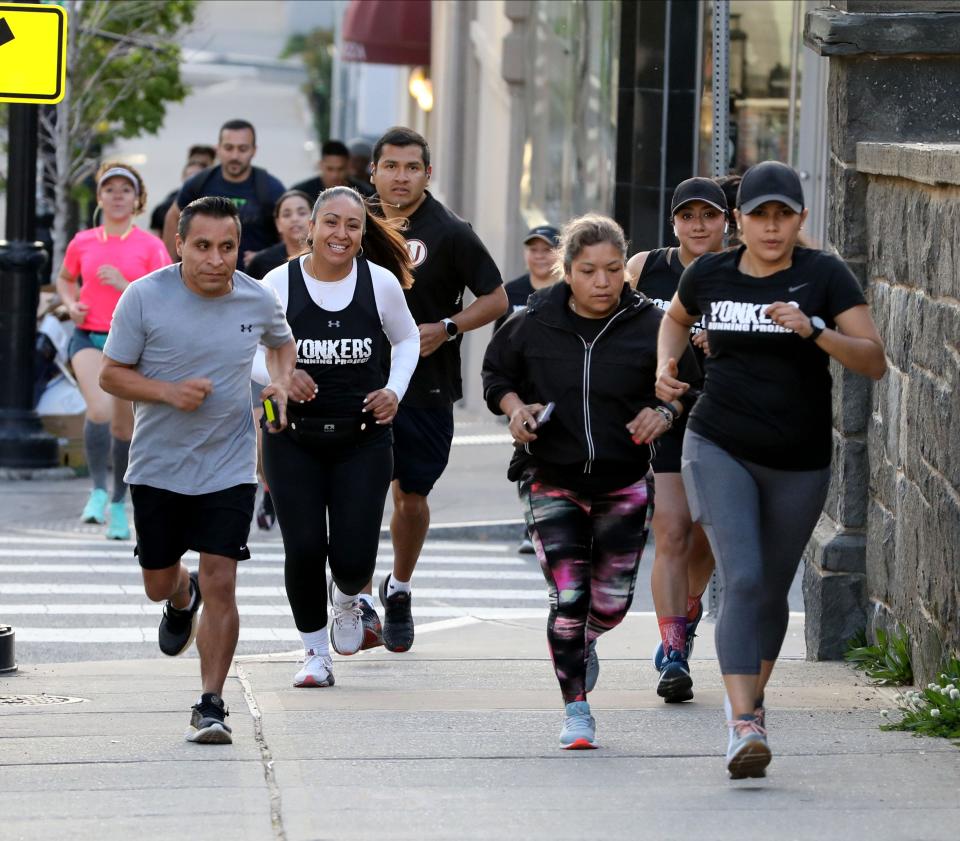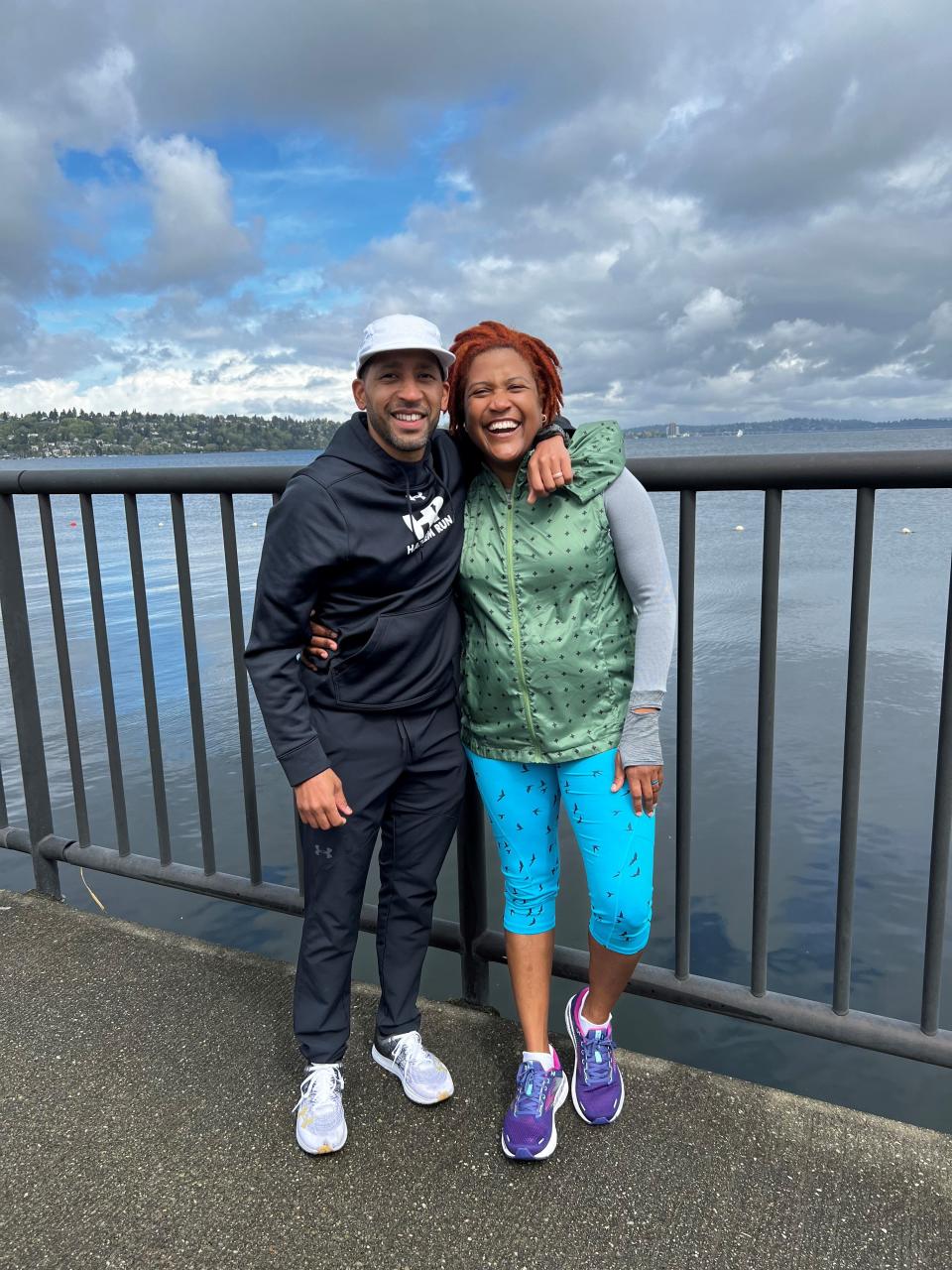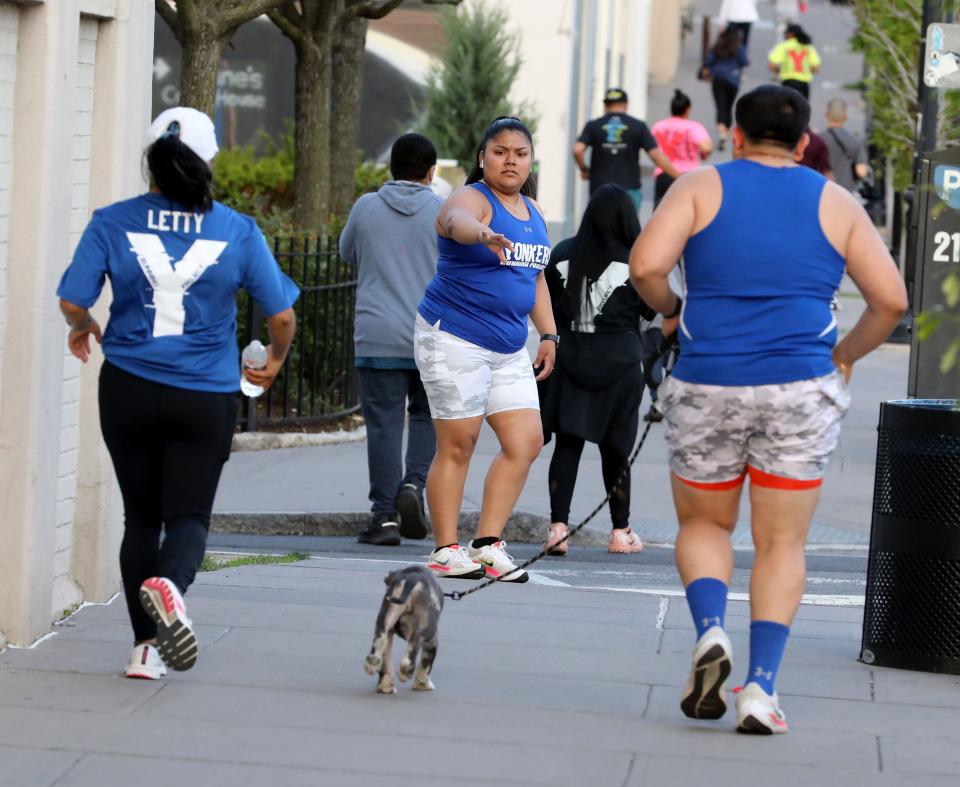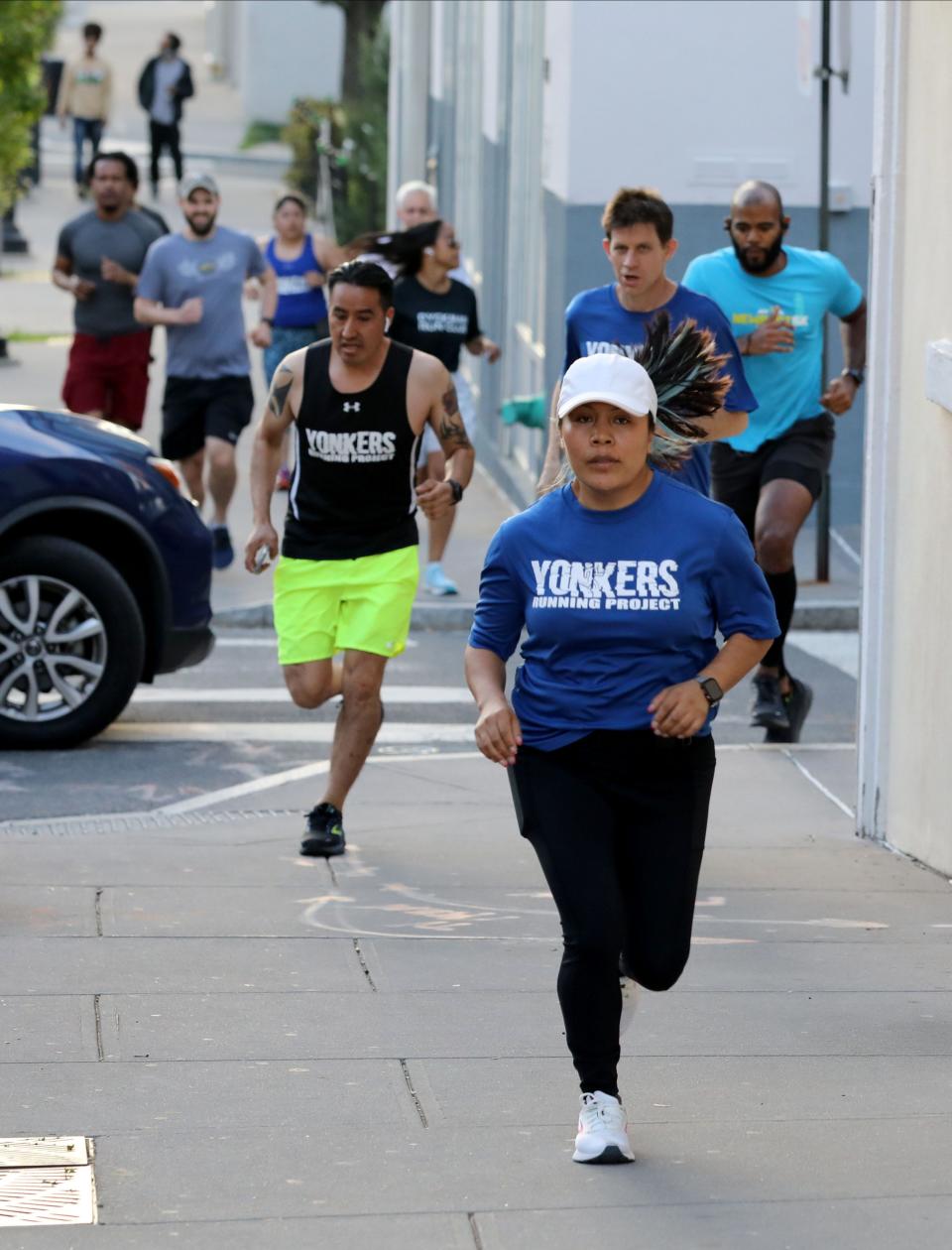This Yonkers run group is partnering to change perspectives on people of color, exercise
The stream of runners started uphill from Yonkers’ Getty Square on a warm Wednesday evening in mid-May. First came walkers and joggers, followed by clusters of people at increasing pace.
They started underneath the Metro-North overpass. They made a left past buildings under construction, vacant lots and bodegas.
“Are y’all running a marathon?” asked a man walking out of a corner store.
Horns honked. Children walking in line clapped. A group at a basketball court yelled to their neighbor, Bridget Lopez, who ran by leading one group.
“Who’s that?” the 33-year-old Yonkers native responded between breaths, then yelled back, “Hi!”

Lopez leads the Yonkers Running Project, which organized the free, weekly five-kilometer run that traverses neighborhoods in the notoriously hilly city. They ran on the third anniversary of the group, which is founded by and composed primarily of people of color.
The Yonkers Running Project is one of a growing number of running clubs in and around New York City that have created communities focused on exercise. They are in neighborhoods that often lacked access to green space and trails, as well as those disparately affected by adverse health effects such as obesity and respiratory illnesses.
After establishing themselves in their neighborhoods, they’re creating connections with other running groups, and sharing best practices — from pre-run stretching to nutrition. They’ve grown even more during the pandemic.
“We’re from different cultures, but in running, we’re all the same,” Yonkers Running Project pacer Andres Matamoros, 31, said in Spanglish, as he guided a mother and son walking along a cracked stretch of flat sidewalk. “We’re all going forward, through the ups and the downs.”
‘That big "Y" on the back’
On March 9, 2019, Maria Acuña gathered a group of runners after connecting with others in Yonkers and on Instagram. Recently, Acuña moved to Maryland, putting Lopez at the helm.
They were the only run group in Yonkers, Lopez said. It was also her first time seriously running. Gradually, she and others got into half-marathons, marathons, and, now, ultra-marathons.
Injustice in Hudson Valley: How civil rights activist W. Haywood Burns started career by integrating a Peekskill pool
Links to the past: Momma Addie's century-old scrapbook links African American history to Tarrytown
Fires, floods, buildings condemned: More than 2,000 Yonkers residents were displaced in the last 5 years. Where did they go?
They first ran at Richter Park, in the city’s more affluent northwest. But it was further from residents they served, Lopez said, so they relocated to Getty Square, the city’s downtown that’s traditionally mostly Black and Latino.
“We wanted it to be welcoming for people on the Southside,” Lopez said on an uphill. “We noticed, since moving, more people have shown up.”
Yonkers native Manny Alfaro, 29, went to one of the first free runs after being invited by Acuña. Like others, he had no running experience, and didn’t remember people jogging in his neighborhood.
Soon, he found himself attending Yonkers Running Project runs, then races. He even designed Yonkers Running Project’s logo and T-shirts: a “Y” on the back.
“We’ve been known for that big ‘Y’ on the back,” he explained. “We’re very distinguishable.”
Yonkers Running Project organizers planned the run with two hills instead of one. At the top of the second hill, more steep than the first, they arrived at Grant Park, overlooking the city and Hudson River.

Crew love
In a brief, sweaty break, they posed for a photo as the waning sun cast orange rays on one of the warmest days in months. They smiled alongside members from Dyckman Run Club of Upper Manhattan, the Bronx Nomads, and Bad Ass Run Krew, groups that came to celebrate with them, in what run clubs call “crew love.”
Growing up along Dyckman Street, Elvin Adames, 32, said runners weren't seen in his predominantly Dominican neighborhood. If he wanted to go to a run club, he’d have to go about a half-mile on the train to Central Park, where most runners were white.
In October 2019, he co-founded Dyckman Run Club with friends, and the group grew exponentially. They’ve since held events alongside Rep. Adriano Espaillat and Mayor Eric Adams.
He felt running is also a more cost-effective form of exercise that has health benefits to address issues such as obesity that disparately affect communities of color.
“I wanted to bring it home and show people how cool it can be, how rewarding it can be,” he said. “We wanted to show everybody, show our community, and hopefully inspire our community and pay it forward.”
There are often barriers for communities of color to engage in exercise.
Dr. Olivia Affuso, a physical activity epidemiologist and an ultra-marathoner in Birmingham, Alabama, studied barriers for Black women to engage in exercise. This included not having enough time with work or family. Other factors also contributed to these barriers, such as built environments, like sidewalks not being maintained in underserved areas, and crime in neighborhoods. Additionally, some areas felt uninviting, like a person unleashing their dog.
Running groups, Affuso found in her research, helped increase physical activity, regardless if people were racing, jogging or walking.
"By having those groups, and having them participate in other running activities, it also increases the awareness of the entire community that there are people of color actually engaged with the activities and engaged with the community," she said.
She cited national organizations such as Black Girls Run, which encourages healthy lifestyles while aiming to address rates of obesity among African American women.
"Now they see them en masse," Affuso said. "It also shifts the perceptions of the general community."

In Harlem, a section of Marcus Garvey Park has been renamed the Harlem Run Plaza, where the local run club founded in 2013 hosts free runs every Monday. Alison Mariella Désir and Amir Muhammad Figueroa founded the group to create a space for Black and brown runners.
The group expanded into an organizing space to push for more lights and assisting people experiencing homelessness in the park.
With groups sprouting up in and around the boroughs since, Désir and Figueroa see their work as giving people a space to walk or run where they otherwise hadn’t. Still, Désir hopes to see more women leading these newly minted groups.
It’s about empowerment, Désir said. She pointed to the killing of Ahmaud Arbery, a 25-year-old Black runner followed and shot by white men while jogging through his Georgia neighborhood.
“The more of us that are moving, the more the running industry recognizes us,” said Désir, whose book “Running While Black” is set to publish this fall. “Black people moving through space is just as common or mundane as white people.”
Perspective shifts
The New York Road Runners, the nonprofit behind the New York City Marathon, has taken note of the growth of these running communities.
CEO Kerin Hempel said there has been a large growth in run crews in the last decade, starting with Harlem Run. Many of these newer groups emphasized social movements rather than traditional run clubs or teams, she added.

The Road Runners has sought to move away from viewing these groups as competition. As a result of the Black Lives Matter movement and, in the fall, the ouster of its previous CEO over accusations of racism and sexism, the nonprofit aims to empower these groups. The Road Runners has focused on the experiences of women, BIPOC communities and people who are gender nonconforming, Hempel added.
"What we want to show is running and how it represents New York,” she said. “Those unique aspects of the crews and clubs really are … what makes our New York City running community special.”
Back in Yonkers on a steep downhill, the runners made their way through a narrow street before arriving along multiple lanes of cars zooming by on Nepperhan Avenue. They passed Jamaican and Salvadoran restaurants as street lights turned on at dusk.
After passing City Hall, they hooked a right before a Popeyes restaurant. The group went down Main Street, underneath red lights of the Metro-North overpass, back to the Pier. They finished with a post-run stretch and raffle for the anniversary.

Jocelyn Jimenez, 33, finished the run with ease, waiting at the pier well after the sun set. She prefers ultra-marathons. She’s already done three, with a fourth planned in her native San Salvador, where she picked up running about five years ago.
But she found her community in the Yonkers Running Project when she moved to the U.S. three years ago. She had searched running clubs’ Instagram accounts and even attended a few in Brooklyn and Manhattan before she found the Yonkers Running Project.
Because she’s quiet, she said, running is her form of expression. It’s also her way to help others, including her family, who started exercising through running. They do weekly runs together, even if she now lives in the U.S. and they’re in El Salvador.
“Now they do it, too,” she said in Spanish, “because I started running.”
After sunset, the runners went to a nearby taqueria and sat together at an outdoor section.
Runners from Dyckman, the Bronx and Dobbs Ferry shared a cake for the Yonkers Running Project’s third birthday.
Eduardo Cuevas covers diversity, equity and inclusion in Westchester and Rockland counties. He can be reached at EMCuevas1@lohud.com and followed on Twitter @eduardomcuevas.
This article originally appeared on Rockland/Westchester Journal News: NY running groups shift perspectives for people of color and exercise

